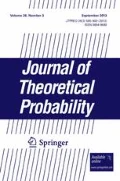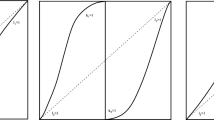Abstract
We consider a continuum percolation model on \(\mathbb {R}^d\), \(d\ge 1\). For \(t,\lambda \in (0,\infty )\) and \(d\in \{1,2,3\}\), the occupied set is given by the union of independent Brownian paths running up to time t whose initial points form a Poisson point process with intensity \(\lambda >0\). When \(d\ge 4\), the Brownian paths are replaced by Wiener sausages with radius \(r>0\). We establish that, for \(d=1\) and all choices of t, no percolation occurs, whereas for \(d\ge 2\), there is a non-trivial percolation transition in t, provided \(\lambda \) and r are chosen properly. The last statement means that \(\lambda \) has to be chosen to be strictly smaller than the critical percolation parameter for the occupied set at time zero (which is infinite when \(d\in \{2,3\}\), but finite and dependent on r when \(d\ge 4\)). We further show that for all \(d\ge 2\), the unbounded cluster in the supercritical phase is unique. Along the way a finite box criterion for non-percolation in the Boolean model is extended to radius distributions with an exponential tail. This may be of independent interest. The present paper settles the basic properties of the model and should be viewed as a springboard for finer results.



Similar content being viewed by others
Notes
The elements of \(\mathcal {R}\) play the role of trifurcation points in the discrete percolation setting.
References
Burton, R.M., Keane, M.: Density and uniqueness in percolation. Commun. Math. Phys. 121(3), 501–505 (1989)
C̆erný, R., Funken, S., Spodarev, E.: On the Boolean model of Wiener sausages. Methodol. Comput. Appl. Probab. 10, 10–23 (2008)
Erhard, D., Martínez, J., Poisat, J.: Brownian Paths Homogeneously Distributed in Space: Percolation Phase Transition and Uniqueness of the Unbounded Cluster. arXiv:1311.2907v1 (2013)
Erhard, D., Poisat, J.: Asymptotics of the Critical Time in Wiener Sausage Percolation with a Small Radius. arXiv:1503.01712 (2015)
Gandolfi, A., Keane, M.S., Newman, C.M.: Uniqueness of the infinite component in a random graph with applications to percolation and spin glasses. Probab. Theory Relat. Fields 92(4), 511–527 (1992)
Gilbert, E.N.: Random plane networks. J. Soc. Ind. Appl. Math. 9(4), 533–543 (1961)
Gouéré, J.-B.: Subcritical regimes in the Poisson Boolean model of continuum percolation. Ann. Probab. 36(4), 1209–1220 (2008)
Kesidis, G., Konstantopoulos, T., Phoha, S.: Surveillance coverage of sensor networks under a random mobility strategy. In: IEEE Sensors Conference, Toronto (2003). Proceedings paper
Liggett, T.M., Schonmann, R.H., Stacey, A.M.: Domination by product measures. Ann. Probab. 25(1), 71–95 (1997)
Menshikov, M.V., Molchanov, S.A., Sidorenko, A.F.: Percolation theory and some applications. In: Probability Theory. Mathematical Statistics. Theoretical Cybernetics, vol. 24 (Russian), Itogi Nauki i Tekhniki, pp. 53–110, i. Akad. Nauk SSSR Vsesoyuz. Inst. Nauchn. i Tekhn. Inform., Moscow, 1986. Translated in J. Soviet Math. 42, (1988), no. 4, 1766–1810
Mörters, P., Peres, Y.: Brownian Motion. Cambridge Series in Statistical and Probabilistic Mathematics. Cambridge University Press, Cambridge (2010)
Meester, R., Roy, R.: Uniqueness of unbounded occupied and vacant components in Boolean models. Ann. Appl. Probab. 4(3), 933–951 (1994)
Meester, R., Roy, R.: Continuum Percolation, Volume 119 of Cambridge Tracts in Mathematics. Cambridge University Press, Cambridge (1996)
Penrose, M.D.: Continuity of critical density in a Boolean model. Unpublished notes (1995)
Peres, Y., Sinclair, A., Sousi, P., Stauffer, A.: Mobile geometric graphs: detection, coverage and percolation. Probab. Theory Relat. Fields 156(1–2), 273–305 (2013)
Peres, Y., Sousi, P., Stauffer, A.: The isolation time of Poisson Brownian motions. ALEA Lat. Am. J Probab. Math. Stat. 10(2), 813–829 (2013)
Sznitman, A.-S.: Vacant set of random interlacements and percolation. Ann. Math. (2) 171(3), 2039–2087 (2010)
van den Berg, J., Meester, R., White, D.: Dynamic Boolean models. Stoch. Process. Appl. 69(2), 247–257 (1997)
Acknowledgments
D.E. and J.P. were supported by ERC Advanced Grant 267356 VARIS. J.P. held a postdoc position at the Mathematical Institute of Leiden University during the preparation of this paper. J.M. was supported by Erasmus Mundus scholarship BAPE-2009-1669. The authors are grateful to R. Meester and M. Penrose for providing unpublished notes, which already contain a sketch of the proof of Proposition 2.2. They thank J.-B. Gouéré for valuable comments on the preliminary version as well as an anonymous referee for suggesting improvements in the presentation of the paper. J.M. is grateful to S. Lopez for valuable discussions.
Author information
Authors and Affiliations
Corresponding author
Appendix: Proof of Lemma 2.3
Appendix: Proof of Lemma 2.3
The proof consists of two steps. In the first step a coarse-graining procedure is introduced, which reduces the problem of showing subcriticality of a continuous percolation model to showing subcriticality of an infinite range site percolation model on \(\mathbb {Z}^d\). This coarse-graining was essentially already introduced in [13, Lemma 3.3], where \(\varrho \) was supposed to have a compact support. To overcome the additional difficulties arising from the long-range dependencies in the coarse-grained model, we use a renormalization scheme, which is similar to the one in Sznitman [17, Theorem 3.5].
Step 1. Coarse-graining
We fix \(N\in \mathbb {N}\). For \(n\in \mathbb {N}\), a sequence of vertices \(z_0,z_1,\ldots , z_{n-1}\) in \(\mathbb {Z}^d\) is called a \(*\)-path when \(\Vert z_i-z_{i-1}\Vert _{\infty }=1\) for all \(i\in \{1,2,\ldots ,n-1\}\). Furthermore, a site \(z = (z(j), 1\le j \le d)\in \mathbb {Z}^d\) is called open when there is an occupied cluster \(\varLambda \) of \(\varSigma \) such that
Otherwise, z is called closed. It was shown in [13, Lemma 3.3] that to obtain Lemma 2.3 it suffices to show that
To prove (6.2) we introduce a renormalization scheme.
Step 2. Renormalization
-
New notation and a first bound We start by introducing new notations. We fix integers \(R>1\) and \(L_0>1\), both to be determined, and we introduce an increasing sequence of scales via
$$\begin{aligned} L_{n+1}=R^{n+1}L_n,\quad n\in \mathbb {N}_0. \end{aligned}$$(6.3)
Moreover, for \(i\in \mathbb {Z}^d\), we introduce a sequence of increasing boxes via
We further abbreviate \(\Box _n=\Box _n(0)\) and \(\boxplus _n=\boxplus _n(0)\). Thus, \(\boxplus _n(i)\) is the union of boxes \(\Box _n(j)\) such that \(\Vert j-i\Vert _{\infty }\le 1\). Moreover, for \(n\in \mathbb {N}\), we introduce the events
and we write \(A_n\) instead of \(A_n(0)\). Here, \(\partial _{\mathrm {int}}\varDelta \) refers to the inner boundary of a set \(\varDelta \subseteq \mathbb {Z}^d\) with respect to the \(\Vert \cdot \Vert _{\infty }\)-norm. The idea of the renormalization scheme is to bound the probability of \(A_{n+1}\) in terms of the probability of the intersection of events \(A_n(i)\) and \(A_n(k)\), where \(i\in \mathbb {Z}^d\) and \(k\in \mathbb {Z}^d\) are thought to be far apart. By the assumption on the radius distribution \(\varrho \), the events \(A_n(i)\) and \(A_n(k)\) can then be treated as being almost independent. This will result in a recursion inequality which relates the probabilities of the events \(A_n\), \(n\in \mathbb {N}\), at different scales. For that, we fix \(n\in \mathbb {N}\) and let
Here, \(\mathrm {dist}(z,\Box _{n+1})\) denotes the distance of z from the set \(\Box _{n+1}\) with respect to the supremum norm. Note that here and in the rest of the proof, for notational convenience, we pretend that expressions like \(L_{n+1}/2\) are integers. Observe that if \(A_{n+1}\) occurs, then there are \(i\in {\mathcal H} _1\) and \(k\in {\mathcal H} _2\) such that both \(A_{n}(i)\) and \(A_{n}(k)\) occur. Hence,
where \(c_1=c_1(d)>0\) is a constant which depends only on the dimension.
-
Partition of \(A_{n}(i)\cap A_n(k)\) We fix \(i\in {\mathcal H} _1\) and \(k\in {\mathcal H} _2\). Let \(z\in \boxplus _n(i)\) and note that to decide if z is open, it suffices to know the trace of the Boolean percolation model on
$$\begin{aligned} \prod _{j=1}^{d}[(z(j)-1)N,(z(j)+2)N). \end{aligned}$$(6.8)
In a similar fashion one sees that the area which determines \(A_n(i)\) is given by
and likewise for \(A_n(k)\). Here, we used that by our choice of R and \(L_0\) the relation \(L_n\ge 2\) holds for all \(n\in \mathbb {N}\). We introduce
and
so that
-
Analysis of the first term on the right-hand side of (6.12) We claim that under \(P_{\lambda ,\varrho }(\cdot |{U_n(i,k)}^{c})\) the events \(A_n(i)\) and \(A_n(k)\) are independent. To see that, note that the Poisson point process \(\chi \) on \(\mathbb {R}^d\times [0,\infty )\) with intensity measure \(\nu =(\lambda \times \mathrm {Leb}_d)\otimes \varrho \) (see Sect. 2.1) is a Poisson point process under \(P_{\lambda ,\varrho }(\cdot | {U_n(i,k)}^{c})\) with intensity measure
$$\begin{aligned} \mathbbm {1}\{\text{ there } \text{ is } \text{ no } (x,r(x))\in \chi \text{ such } \text{ that } {\mathcal D} (x,r(x)) \text{ occurs }\}\times \nu . \end{aligned}$$(6.13)
However, on \( {U_n(i,k)}^{c}\), the events \(A_n(i)\) and \(A_n(k)\) depend on disjoint subsets of \(\mathbb {R}^d\times [0,\infty )\). Consequently, they are independent under \(P_{\lambda ,\varrho }(\cdot |{U_n(i,k)}^{c})\). Hence,
For the last inequality in (6.14) we used the fact that \(P_{\lambda ,\varrho }(A_n(i))\) does not depend on \(i\in \mathbb {Z}^d\).
-
Analysis of the second term on the right-hand side of (6.12) To bound the second term on the right-hand side of (6.12) it will be enough to bound \(P_{\lambda ,\varrho }(U_n(i,k))\) from above, since the other term is less than one. Note that
$$\begin{aligned}&P_{\lambda ,\varrho }(U_n(i,k))\nonumber \\&\quad \le \sum _{\ell \in 3\mathbb {Z}^d} P_{\lambda ,\varrho } \Bigg ( \begin{array}{ll} \exists x\in {\mathcal E} \cap N\boxplus _{n+1}(\ell ) :&{} {\mathcal B} (x,r(x)) \cap \mathrm {DET}(\boxplus _n(i)) \ne \emptyset \\ \text{ and } &{}{\mathcal B} (x,r(x)) \cap \mathrm {DET}(\boxplus _n(k)) \ne \emptyset \end{array} \Bigg ).\nonumber \\ \end{aligned}$$(6.15)
Here, the set \(N\boxplus _{n+1}(\ell )\) is the set \(\{x\in \mathbb {R}^d\,:\, x=zN, z\in \boxplus _{n+1}(\ell )\}\). We first treat the term \(\ell =0\) in the sum in (6.15). Note that for all \(n\in \mathbb {N}\),
provided R and \(L_0\) are chosen accordingly. Thus, if there is a Poisson point whose corresponding ball intersects \(\mathrm {DET}(\boxplus _n(i))\) and \(\mathrm {DET}(\boxplus _n(k))\), then its radius is at least \(L_{n+1}N/6\). This yields
We may bound the right-hand side of (6.17) by
which is at most \(\lambda \mathrm {Leb}_d(N\boxplus _{n+1}) \varrho ([L_{n+1}N/6,\infty ))\). By our assumption on the radius distribution, for R and \(L_0\) large enough, there is a constant \(c_2=c_2(\varrho )>0\) such that the last term may be bounded from above by \(\lambda (3L_{n+1}N)^de^{-c_2L_{n+1}N/6}\). The case \(\ell > 0\) is treated in a similar manner. Thus, the left-hand side of (6.15) is at most
This is bounded from above by
for some constant \(c_3>0\) which is independent of R, \(L_0\) and N. Hence, we have bounded the second term on the right-hand side of (6.12). In particular, by the above considerations, we deduce that for all \(n\in \mathbb {N}\) and for a suitable choice of R and \(L_0\), \(P_{\lambda ,\varrho }({U_n(i,k)}^{c})\ge 1/2\).
-
Analysis of the recursion scheme Equation (6.7) in combination with (6.12) and the arguments following it shows that
$$\begin{aligned} P_{\lambda ,\varrho }(A_{n+1}) \le 2c_1R^{2(d-1)(n+1)}\Big (P_{\lambda ,\varrho }(A_n)^2 + c_3\lambda (3L_{n+1}N)^de^{-c_2L_{n+1}N/6}\Big ). \end{aligned}$$(6.21)
To proceed, we put
Claim 6.1
For R large enough, for all \(n\in {\mathbb N} \) and for all \(L_0\ge 2R^{4(d-1)+1}\), the inequality \(a_n\le L_n^{-1}\) implies that \(a_{n+1}\le L_{n+1}^{-1}\).
Proof
Let \(n\in \mathbb {N}\) and assume that \(a_n\le L_n^{-1}\). Then,
Thus, it is enough to show that
For that, note that by our assumption on \(a_n\),
Thus, choosing \(L_0\ge 2R^{4(d-1)+1}\) yields the first desired inequality. The second term on the right-hand side of (6.23) may be bounded from above using similar considerations. This yields Claim 6.1. \(\square \)
Hence, to use the claim, we need that \(P_{\lambda ,\varrho }(A_0)\le L_0^{-1}\). Observe that
where \(c_4=c_4(d)>0\) does only depend on the dimension. Equation (3.64) in [13] shows that
Therefore, if the right-hand side of (6.27) is smaller than \((4dc_1c_4L_0^{d})^{-1}\), we get from (6.26) that \(P_{\lambda ,\varrho }(A_0)\le (2c_1L_0)^{-1}\), thus \(a_0\le L_0^{-1}\). Note that an infinite \(*\)-path of open sites containing zero implies \(A_n\) for all \(n\in {\mathbb N} \). Thus, Claim 6.1 finally yields
Consequently, Lemma 2.3 holds for \(\varepsilon \le (4dc_1c_4L_0^{d+1})^{-1}\).
Rights and permissions
About this article
Cite this article
Erhard, D., Martínez, J. & Poisat, J. Brownian Paths Homogeneously Distributed in Space: Percolation Phase Transition and Uniqueness of the Unbounded Cluster. J Theor Probab 30, 784–812 (2017). https://doi.org/10.1007/s10959-015-0661-5
Received:
Revised:
Published:
Issue Date:
DOI: https://doi.org/10.1007/s10959-015-0661-5




